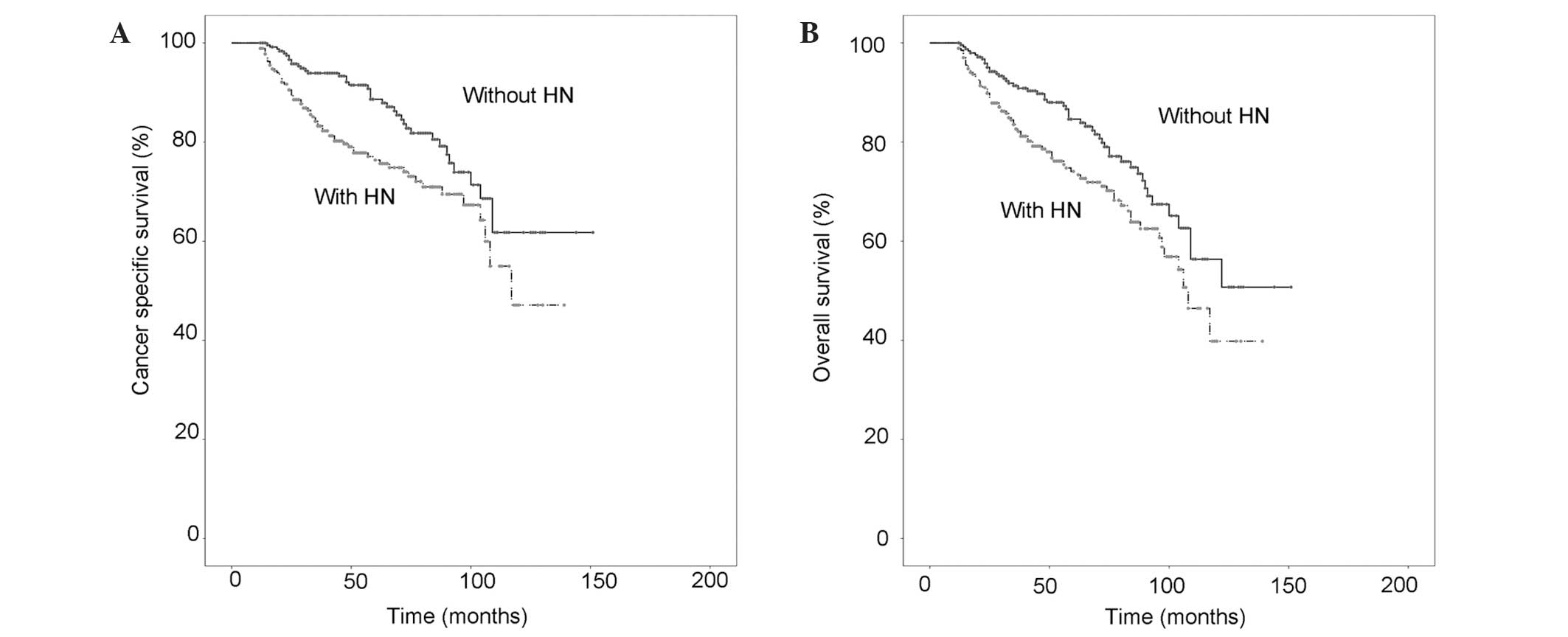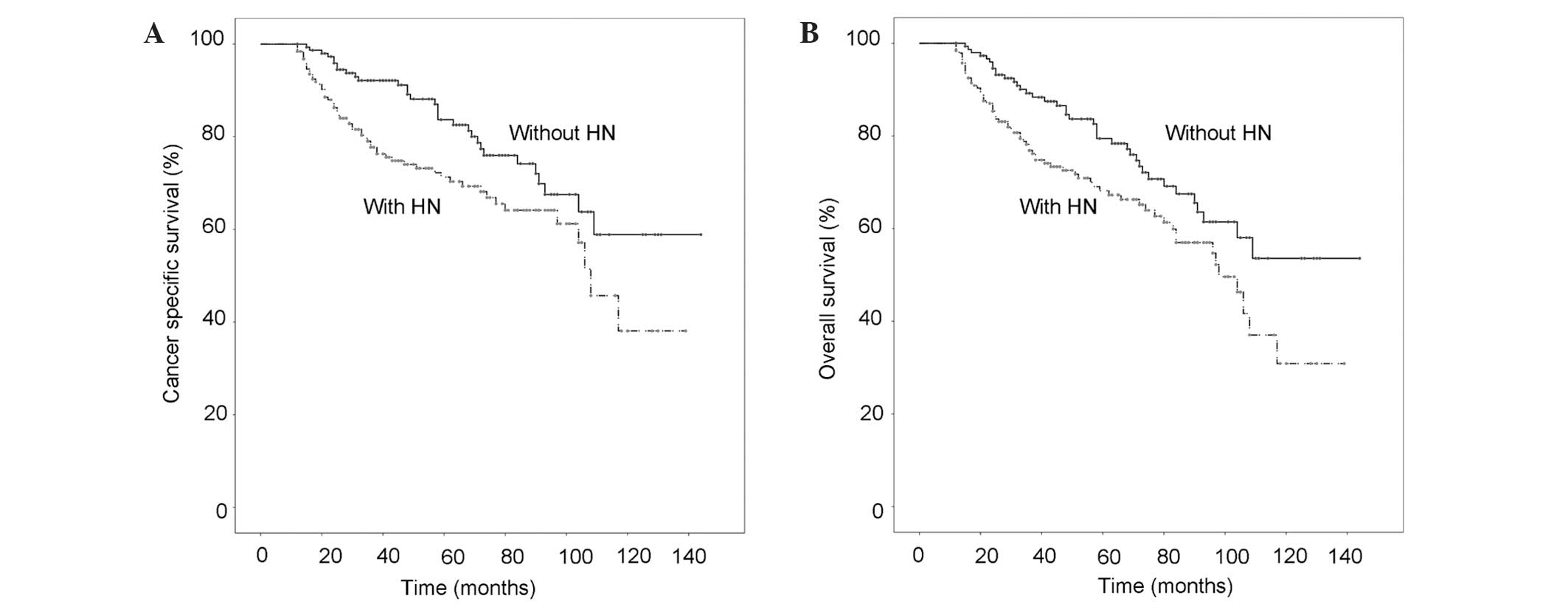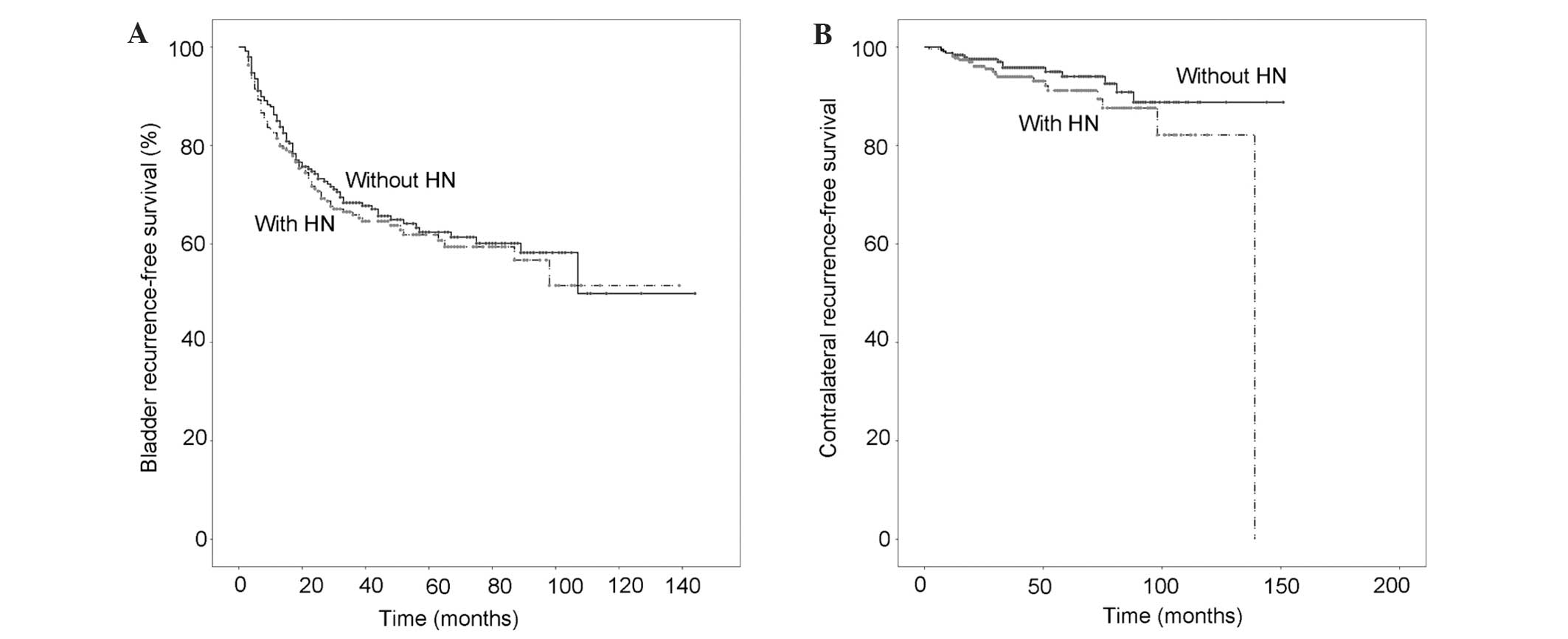|
1
|
Siegel R, Naishadham D and Jemal A: Cancer
statistics, 2012. CA Cancer J Clin. 62:10–29. 2012. View Article : Google Scholar : PubMed/NCBI
|
|
2
|
Pérez M Pérez-Utrilla, Bazán A Aguilera,
Dorrego JM Alonso, et al: Simultaneous cystectomy and
nephroureterectomy due to synchronous upper urinary tract tumors
and invasive bladder cancer: Open and laparoscopic approaches. Curr
Urol. 6:76–81. 2012. View Article : Google Scholar : PubMed/NCBI
|
|
3
|
Cummings KB: Nephroureterectomy: Rationale
in the management of transitional cell carcinoma of the upper
urinary tract. Urol Clin North Am. 7:569–578. 1980.PubMed/NCBI
|
|
4
|
McLaughlin JK, Silverman DT, Hsing AW, et
al: Cigarette smoking and cancers of the renal pelvis and ureter.
Cancer Res. 52:254–257. 1992.PubMed/NCBI
|
|
5
|
Colin P, Koenig P, Ouzzane A, et al:
Environmental factors involved in carcinogenesis of urothelial cell
carcinomas of the upper urinary tract. BJU Int. 104:1436–1440.
2009. View Article : Google Scholar : PubMed/NCBI
|
|
6
|
Cowan NC: CT urography for hematuria. Nat
Rev Urol. 9:218–226. 2012. View Article : Google Scholar : PubMed/NCBI
|
|
7
|
Sobin L, Gospodarowicz M and Wittekind C:
Urological tumours. Renal pelvis and ureter. TNM Classification of
Malignant Tumours (7th). Wiley-Blackwell. (Hoboken, NJ). 258–261.
2009.
|
|
8
|
Rink M, Ehdaie B, Cha EK, et al: Bladder
Cancer Research Consortium (BCRC); Upper Tract Urothelial Carcinoma
Collaboration (UTUCC): Stage-specific impact of tumor location on
oncologic outcomes in patients with upper and lower tract
urothelial carcinoma following radical surgery. Eur Urol.
62:677–684. 2012. View Article : Google Scholar : PubMed/NCBI
|
|
9
|
Cha EK, Shariat SF, Kormaksson M, et al:
Predicting clinical outcomes after radical nephroureterectomy for
upper tract urothelial carcinoma. Eur Urol. 61:818–825. 2012.
View Article : Google Scholar : PubMed/NCBI
|
|
10
|
Roupret M, Babjuk M, Comperat E, et al:
European Association of Urology: European guidelines on upper tract
urothelial carcinomas: 2013 update. Eur Urol. 63:1059–1071. 2013.
View Article : Google Scholar : PubMed/NCBI
|
|
11
|
Margulis V, Shariat SF, Matin SF, et al:
Outcomes of radical nephroureterectomy: A series from the upper
tract urothelial carcinoma collaboration. Cancer. 115:1224–1233.
2009. View Article : Google Scholar : PubMed/NCBI
|
|
12
|
Gadzinski AJ, Roberts WW, Faerber GJ and
Wolf JS Jr: Long-term outcomes of nephroureterectomy versus
endoscopic management for upper tract urothelial carcinoma. J Urol.
183:2148–2153. 2010. View Article : Google Scholar : PubMed/NCBI
|
|
13
|
Colin P, Ouzzane A, Pignot G, et al:
Comparison of oncological outcomes after segmental ureterectomy or
radical nephroureterectomy in urothelial carcinomas of the upper
urinary tract: Results from a large French multicentre study. BJU
Int. 110:1134–1141. 2012. View Article : Google Scholar : PubMed/NCBI
|
|
14
|
Murphy DM, Zincke H and Furlow WL: Primary
grade 1 transitional cell carcinoma of the renal pelvis and ureter.
J Urol. 123:629–631. 1980.PubMed/NCBI
|
|
15
|
Matin SF, Margulis V, Kamat A, et al:
Incidence of downstaging and complete remission after neoadjuvant
chemotherapy for high-risk upper tract transitional cell carcinoma.
Cancer. 116:3127–3134. 2010. View Article : Google Scholar : PubMed/NCBI
|
|
16
|
Youssef RF, Shariat SF, Lotan Y, et al:
Upper urinary tract urothelial carcinoma with loco-regional nodal
metastases: Insights from the upper tract urothelial carcinoma
collaboration. BJU Int. 108:1286–1291. 2011. View Article : Google Scholar : PubMed/NCBI
|
|
17
|
Ng CK, Shariat SF, Lucas SM, et al: Does
the presence of hydronephrosis on preoperative axial CT imaging
predict worse outcomes for patients undergoing nephroureterectomy
for upper-tract urothelial carcinoma? Urol Oncol. 29:27–32. 2011.
View Article : Google Scholar : PubMed/NCBI
|
|
18
|
Divrik RT, Sahin A, Altok M, Unlu N and
Zorlu F: The frequency of hydronephrosis at initial diagnosis and
its effect on recurrence and progression in patients with
superficial bladder cancer. J Urol. 178:802–806. 2007. View Article : Google Scholar : PubMed/NCBI
|
|
19
|
Haleblian GE, Skinner EC, Dickinson MG,
Lieskovsky G, Boyd SD and Skinner DG: Hydronephrosis as a
prognostic indicator in bladder cancer patients. J Urol.
160:2011–2014. 1998. View Article : Google Scholar : PubMed/NCBI
|
|
20
|
Bartsch GC, Kuefer R, Gschwend JE, de
Petriconi R, Hautmann RE and Volkmer BG: Hydronephrosis as a
prognostic marker in bladder cancer in a cystectomy-only series.
Eur Urol. 51:690–697. 2007. View Article : Google Scholar : PubMed/NCBI
|
|
21
|
Chen XP, Xiong GY, Li XS, Matin SF, Garcia
M, Fang D, Wang TY, Yu W, Gong K, Song Y, et al: Predictive factors
for worse pathological outcomes of upper tract urothelial
carcinoma: Experience from a nationwide high-volume centre in
China. BJU Int. 112:917–924. 2013.PubMed/NCBI
|
|
22
|
Ito Y, Kikuchi E, Tanaka N, Miyajima A,
Mikami S, Jinzaki M and Oya M: Preoperative hydronephrosis grade
independently predicts worse pathological outcomes in patients
undergoing nephroureterectomy for upper tract urothelial carcinoma.
J Urol. 185:1621–1626. 2011. View Article : Google Scholar : PubMed/NCBI
|
|
23
|
Messer JC, Terrell JD, Herman MP, Ng CK,
Scherr DS, Scoll B, Boorjian SA, Uzzo RG, Wille M, Eggener SE, et
al: Multi-institutional validation of the ability of preoperative
hydronephrosis to predict advanced pathologic tumor stage in
upper-tract urothelial carcinoma. Urol Oncol. 31:904–908. 2013.
View Article : Google Scholar : PubMed/NCBI
|
|
24
|
Brien JC, Shariat SF, Herman MP, Ng CK,
Scherr DS, Scoll B, Uzzo RG, Wille M, Eggener SE, Terrell JD, et
al: Preoperative hydronephrosis, ureteroscopic biopsy grade and
urinary cytology can improve prediction of advanced upper tract
urothelial carcinoma. J Urol. 184:69–73. 2010. View Article : Google Scholar : PubMed/NCBI
|
|
25
|
Hwang I, Jung SI, Nam DH, Hwang EC, Kang
TW, Kwon DD and Ryu SB: Preoperative hydronephrosis and diabetes
mellitus predict poor prognosis in upper urinary tract urothelial
carcinoma. Can Urol Assoc J. 7:E215–E220. 2013. View Article : Google Scholar : PubMed/NCBI
|
|
26
|
Ma YC, Zuo L, Chen JH, Luo Q, Yu XQ, Li Y,
Xu JS, Huang SM, Wang LN, Huang W, et al: Modified glomerular
filtration rate estimating equation for Chinese patients with
chronic kidney disease. J Am Soc Nephrol. 17:2937–2944. 2006.
View Article : Google Scholar : PubMed/NCBI
|
|
27
|
Bozzini G, Nison L, Colin P, Ouzzane A,
Yates DR, Audenet F, Pignot G, Arvin-Berod A, Merigot O, Guy L, et
al: Influence of preoperative hydronephrosis on the outcome of
urothelial carcinoma of the upper urinary tract after
nephroureterectomy: The results from a multi-institutional French
cohort. World J Urol. 31:83–91. 2013. View Article : Google Scholar : PubMed/NCBI
|
|
28
|
Akdogan B, Dogan HS, Eskicorapci SY, Sahin
A, Erkan I and Ozen H: Prognostic significance of bladder tumor
history and tumor location in upper tract transitional cell
carcinoma. J Urol. 176:48–52. 2006. View Article : Google Scholar : PubMed/NCBI
|
|
29
|
Ouzzane A, Colin P, Xylinas E, Pignot G,
Ariane MM, Saint F, Hoarau N, Adam E, Azemar MD, Bensadoun H, et
al: Ureteral and multifocal tumours have worse prognosis than renal
pelvic tumours in urothelial carcinoma of the upper urinary tract
treated by nephroureterectomy. Eur Urol. 60:1258–1265. 2011.
View Article : Google Scholar : PubMed/NCBI
|
|
30
|
Zhang X, Zhu Z, Zhong S, Xu T and Shen Z:
Ureteral tumours showing a worse prognosis than renal pelvis
tumours may be attributed to ureteral tumours more likely to have
hydronephrosis and less likely to have haematuria. World J Urol.
31:155–160. 2013. View Article : Google Scholar : PubMed/NCBI
|
|
31
|
Azémar MD, Comperat E, Richard F, Cussenot
O and Rouprêt M: Bladder recurrence after surgery for upper urinary
tract urothelial cell carcinoma: Frequency, risk factors and
surveillance. Urol Oncol. 29:130–136. 2011. View Article : Google Scholar : PubMed/NCBI
|
|
32
|
Silberstein JL, Power NE, Savage C, Tarin
TV, Favaretto RL, Su D, Kaag MG, Herr HW and Dalbagni G: Renal
function and oncologic outcomes of parenchymal sparing ureteral
resection versus radical nephroureterectomy for upper tract
urothelial carcinoma. J Urol. 187:429–434. 2012. View Article : Google Scholar : PubMed/NCBI
|
|
33
|
Hall MC, Womack S, Sagalowsky AI, Carmody
T, Erickstad MD and Roehrborn CG: Prognostic factors, recurrence
and survival in transitional cell carcinoma of the upper urinary
tract: A 30-year experience in 252 patients. Urology. 52:594–601.
1998. View Article : Google Scholar : PubMed/NCBI
|
|
34
|
Hellenthal NJ, Shariat SF, Margulis V,
Karakiewicz PI, Roscigno M, Bolenz C, Remzi M, Weizer A, Zigeuner
R, Bensalah K, et al: Adjuvant chemotherapy for high risk upper
tract urothelial carcinoma: Results from the upper tract urothelial
carcinoma collaboration. J Urol. 182:900–906. 2009. View Article : Google Scholar : PubMed/NCBI
|
|
35
|
Audenet F, Yates DR, Cussenot O and
Roupret M: The role of chemotherapy in the treatment of urothelial
cell carcinoma of the upper urinary tract (UUT-UCC). Urol Oncol.
31:407–413. 2013. View Article : Google Scholar : PubMed/NCBI
|
|
36
|
O'Donnell PH and Stadler WM: The role of
chemotherapy in upper tract urothelial carcinoma. Adv Urol.
2009:4190282009. View Article : Google Scholar
|
|
37
|
Hoshino K, Kikuchi E, Tanaka N, Akita H,
Ito Y, Miyajima A, Jinzaki M and Oya M: Preoperative
hydronephrosis: Independent predictor for changes in renal function
following nephroureterectomy. Jpn J Clin Oncol. 42:202–207. 2012.
View Article : Google Scholar : PubMed/NCBI
|
|
38
|
Wang SM, Lai MN, Chen PC, Pu YS, Lai MK,
Hwang JS and Wang JD: Increased upper and lower tract urothelial
carcinoma in patients with end-stage renal disease: A nationwide
cohort study in Taiwan during 1997–2008. Biomed Res Int.
2014:1497502014.PubMed/NCBI
|
|
39
|
Chen CH, Dickman KG, Moriya M, Zavadil J,
Sidorenko VS, Edwards KL, Gnatenko DV, Wu L, Turesky RJ, Wu XR, et
al: Aristolochic acid-associated urothelial cancer in Taiwan. Proc
Natl Acad Sci USA. 109:8241–8246. 2012. View Article : Google Scholar : PubMed/NCBI
|
|
40
|
Chou YH and Huang CH: Unusual clinical
presentation of upper urothelial carcinoma in Taiwan. Cancer.
85:1342–1344. 1999. View Article : Google Scholar : PubMed/NCBI
|
|
41
|
Yu W, Zhao YY, Shen Q, Yang XY, He Q, Song
Y and Jin J: Gender-related differences in pathological
characteristics of upper urinary tract urothelial carcinoma:
Analysis of 597 cases. Beijing Da Xue Xue Bao. 43:522–524. 2011.(In
Chinese). PubMed/NCBI
|












